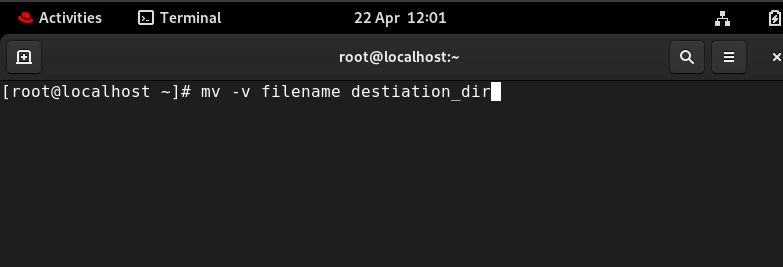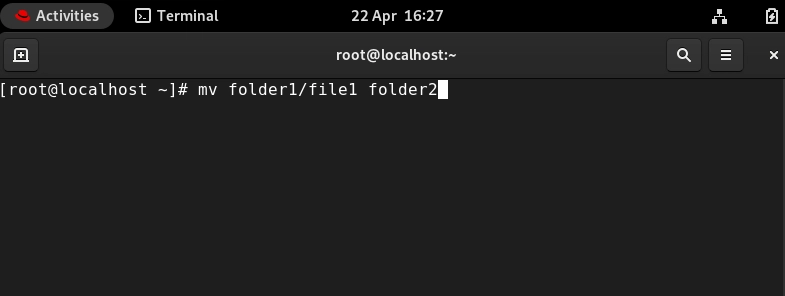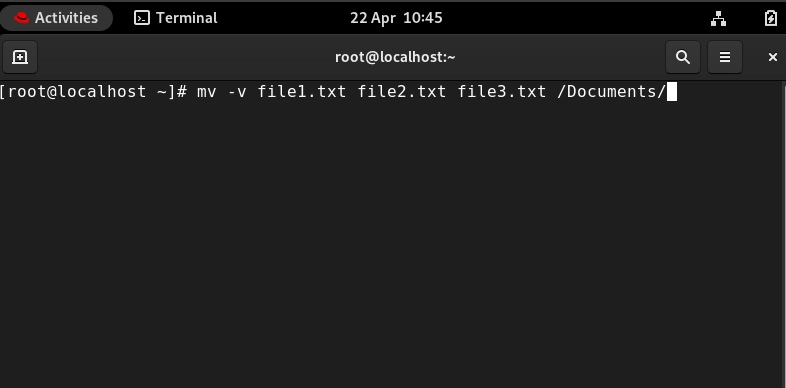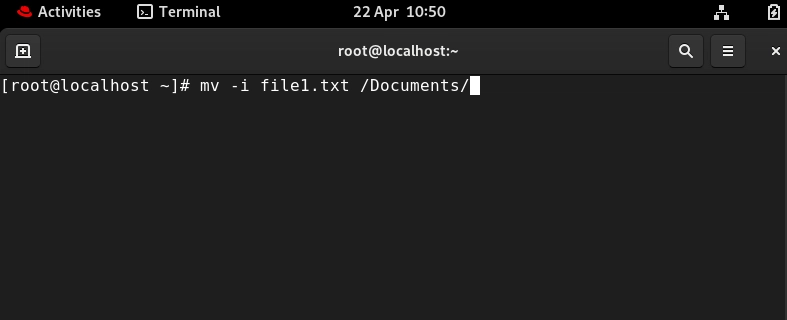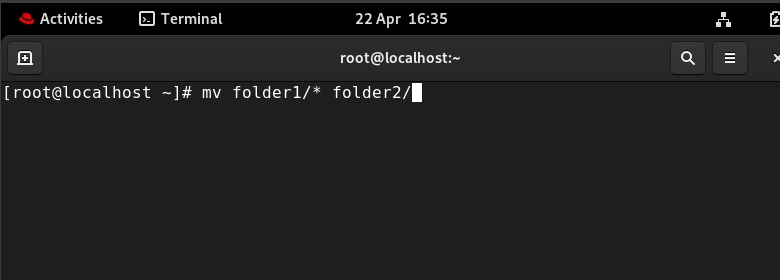From chaos to order: how the mv command simplifies Linux file management
The mv command in Linux is an essential and versatile tool for managing files and directories. Its primary purpose is to move files or directories from one location to another, but it also serves as a straightforward way to rename them. Whether you’re organizing your files or just tidying up your system, mv is the command you’ll frequently rely on. Table of Contents What Does mv Do? Basic Syntax Common Options Rename a file Move a file to another directory Move multiple files to a directory with verbose output Move all .txt files to a directory Move all files to another directory Rename a directory: Tips for Safe Usage Alternative way to move files in Linux Conclusion What Does mv Do? At its core, mv performs two main functions: moving files or directories from one place to another within the filesystem renaming files or directories by moving them to the same location but with a different name This dual functionality makes it a powerful command for daily file management tasks. Basic Syntax The general syntax of the mv command is: mv [options] source destination source: the file or directory you want to move or rename destination: the target location or new name For example, to rename a file: mv oldname.txt newname.txt Or to move a file to another directory: mv file.txt /path/to/destination/ Common Options mv supports several options that enhance its usability: Option Description -i (interactive) prompts before overwriting an existing file, preventing accidental data loss. -f (force) forces the move without any prompts, overwriting files silently. -v (verbose) shows detailed output of what mv is doing, useful for tracking actions mv -v filename destination_dir/ -u (update) moves the file only if the source is newer than the destination or if the destination does not exist. -b (backup) creates a backup of existing destination files before overwriting, appending a to the backup file's name. Practical Examples Rename a file mv report.txt report_old.txt Move a file to another directory mv folder1/file1 folder2/ Move multiple files to a directory with verbose output mv -v file1.txt file2.txt file3.txt /Documents/ Prompt before overwriting a file: mv -i file1.txt /Documents/ Move all .txt files to a directory mv *.txt destination_directory/ Move all files to another directory mv folder1/* folder2/ Rename a directory: mv projects projects_old Tips for Safe Usage Always double-check the source and destination paths to avoid accidental overwrites Use the -i option if you want to be prompted before overwriting files The -v option is handy when you want to see exactly what files are being moved or renamed When moving large directories or multiple files, consider using wildcards (*) to specify groups of files efficiently Alternative way to move files in Linux The cp command is used to copy files and directories in Linux. If you want to copy an entire directory, you need to add the -r(recursive) option, which tells cp to copy all files and subfolders inside that directory. For example, cp -r source_dir/ destination_dir/ will copy everything from the source to the destination. However, this does not actually move the files, it just makes a copy. If you want to move files or directories (removing them from the original location), you should use the mv command instead. Conclusion The mv command is a simple yet powerful utility that every Linux user should master. It streamlines file organization by enabling quick moves and renames, whether you’re handling a single file or an entire directory. With a few options and a clear understanding of its syntax, mv can significantly improve your command-line workflow and keep your filesystem neat and orderly. Mastering mv is a step toward becoming more proficient in Linux file management, making your day-to-day tasks smoother and more efficient.

The mv command in Linux is an essential and versatile tool for managing files and directories.
Its primary purpose is to move files or directories from one location to another, but it also serves as a straightforward way to rename them. Whether you’re organizing your files or just tidying up your system, mv is the command you’ll frequently rely on.
Table of Contents
- What Does mv Do?
- Basic Syntax
- Common Options
- Rename a file
- Move a file to another directory
- Move multiple files to a directory with verbose output
- Move all .txt files to a directory
- Move all files to another directory
- Rename a directory:
- Tips for Safe Usage
- Alternative way to move files in Linux
- Conclusion
At its core, mv performs two main functions:
moving files or directories from one place to another within the
filesystemrenaming files or directories by moving them to the same location but
with a different name
This dual functionality makes it a powerful command for daily file management tasks.
The general syntax of the mv command is:
mv [options] source destination
- source: the file or directory you want to move or rename
- destination: the target location or new name
For example, to rename a file:
mv oldname.txt newname.txt
Or to move a file to another directory:
mv file.txt /path/to/destination/
mv supports several options that enhance its usability:
Option Description
-i (interactive) prompts before overwriting an existing file, preventing accidental data loss.
-f (force) forces the move without any prompts, overwriting files silently.
-v (verbose) shows detailed output of what mv is doing, useful for tracking actions
mv -v filename destination_dir/
-u (update) moves the file only if the source is newer than the destination or if the destination does not exist.
-b (backup) creates a backup of existing destination files before overwriting, appending a to the backup file's name.
Practical Examples
mv report.txt report_old.txt
Move a file to another directory
mv folder1/file1 folder2/
Move multiple files to a directory with verbose output
mv -v file1.txt file2.txt file3.txt /Documents/
Prompt before overwriting a file:
mv -i file1.txt /Documents/
Move all .txt files to a directory
mv *.txt destination_directory/
Move all files to another directory
mv folder1/* folder2/
mv projects projects_old
- Always double-check the source and destination paths to avoid accidental overwrites
- Use the -i option if you want to be prompted before overwriting files
- The -v option is handy when you want to see exactly what files are being moved or renamed
- When moving large directories or multiple files, consider using wildcards (*) to specify groups of files efficiently
Alternative way to move files in Linux
The cp command is used to copy files and directories in Linux. If you want to copy an entire directory, you need to add the -r(recursive) option, which tells cp to copy all files and subfolders inside that directory.
For example, cp -r source_dir/ destination_dir/ will copy everything from the source to the destination.

However, this does not actually move the files, it just makes a copy.
If you want to move files or directories (removing them from the original location), you should use the mv command instead.
The mv command is a simple yet powerful utility that every Linux user should master.
It streamlines file organization by enabling quick moves and renames, whether you’re handling a single file or an entire directory.
With a few options and a clear understanding of its syntax, mv can significantly improve your command-line workflow and keep your filesystem neat and orderly.
Mastering mv is a step toward becoming more proficient in Linux file management, making your day-to-day tasks smoother and more efficient.













































































































































































![[The AI Show Episode 144]: ChatGPT’s New Memory, Shopify CEO’s Leaked “AI First” Memo, Google Cloud Next Releases, o3 and o4-mini Coming Soon & Llama 4’s Rocky Launch](https://www.marketingaiinstitute.com/hubfs/ep%20144%20cover.png)
























































































































































![BPMN-procesmodellering [closed]](https://i.sstatic.net/l7l8q49F.png)


























































































-All-will-be-revealed-00-35-05.png?width=1920&height=1920&fit=bounds&quality=70&format=jpg&auto=webp#)
-All-will-be-revealed-00-17-36.png?width=1920&height=1920&fit=bounds&quality=70&format=jpg&auto=webp#)
-Jack-Black---Steve's-Lava-Chicken-(Official-Music-Video)-A-Minecraft-Movie-Soundtrack-WaterTower-00-00-32_lMoQ1fI.png?width=1920&height=1920&fit=bounds&quality=70&format=jpg&auto=webp#)








































































































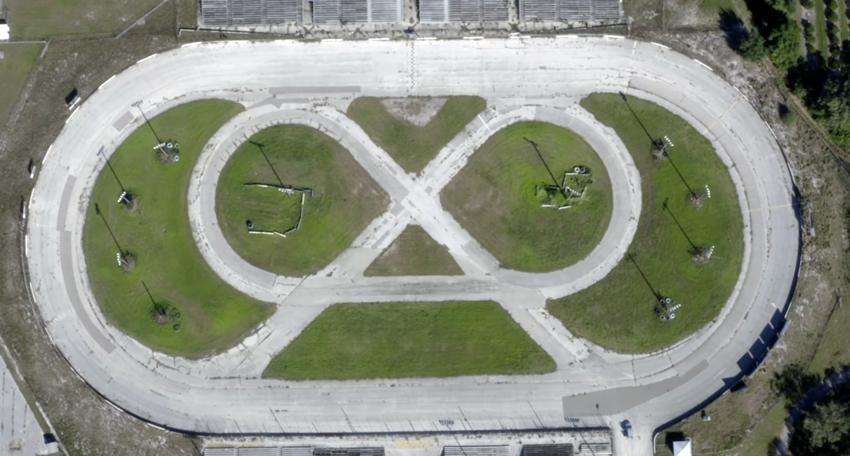













![What iPhone 17 model are you most excited to see? [Poll]](https://9to5mac.com/wp-content/uploads/sites/6/2025/04/iphone-17-pro-sky-blue.jpg?quality=82&strip=all&w=290&h=145&crop=1)

















![Hands-On With 'iPhone 17 Air' Dummy Reveals 'Scary Thin' Design [Video]](https://www.iclarified.com/images/news/97100/97100/97100-640.jpg)
![Mike Rockwell is Overhauling Siri's Leadership Team [Report]](https://www.iclarified.com/images/news/97096/97096/97096-640.jpg)
![Instagram Releases 'Edits' Video Creation App [Download]](https://www.iclarified.com/images/news/97097/97097/97097-640.jpg)
![Inside Netflix's Rebuild of the Amsterdam Apple Store for 'iHostage' [Video]](https://www.iclarified.com/images/news/97095/97095/97095-640.jpg)




























































































































